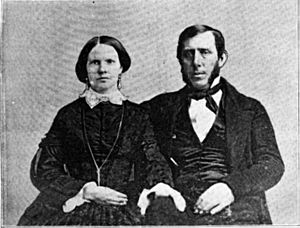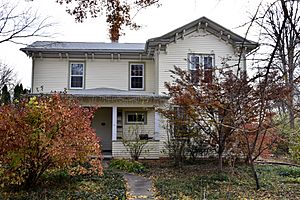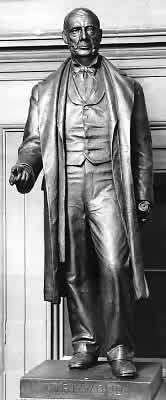Samuel J. Kirkwood facts for kids
Quick facts for kids
Samuel Kirkwood
|
|
|---|---|
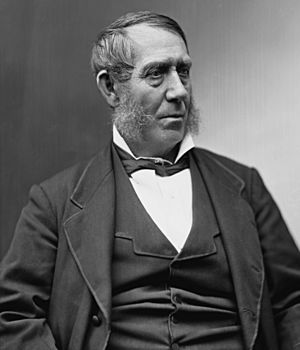 |
|
| 14th United States Secretary of the Interior | |
| In office March 8, 1881 – April 17, 1882 |
|
| President | James A. Garfield Chester A. Arthur |
| Preceded by | Carl Schurz |
| Succeeded by | Henry M. Teller |
| United States Senator from Iowa |
|
| In office March 4, 1877 – March 7, 1881 |
|
| Preceded by | George G. Wright |
| Succeeded by | James W. McDill |
| In office January 13, 1866 – March 3, 1867 |
|
| Preceded by | James Harlan |
| Succeeded by | James Harlan |
| 5th and 9th Governor of Iowa | |
| In office January 13, 1876 – February 1, 1877 |
|
| Lieutenant | Joshua G. Newbold |
| Preceded by | Cyrus C. Carpenter |
| Succeeded by | Joshua G. Newbold |
| In office January 11, 1860 – January 14, 1864 |
|
| Lieutenant | Nicholas J. Rusch John R. Needham |
| Preceded by | Ralph P. Lowe |
| Succeeded by | William M. Stone |
| Personal details | |
| Born |
Samuel Jordan Kirkwood
December 20, 1813 Harford County, Maryland, U.S. |
| Died | September 1, 1894 (aged 80) Iowa City, Iowa, U.S. |
| Resting place | Oakland Cemetery |
| Political party | Republican |
| Spouse | Jane Clark |
| Signature | |
Samuel Jordan Kirkwood (December 20, 1813 – September 1, 1894) was an American politician who twice served as governor of Iowa, twice as a U.S. Senator from Iowa, and as the U.S. Secretary of the Interior.
Contents
Early life and career
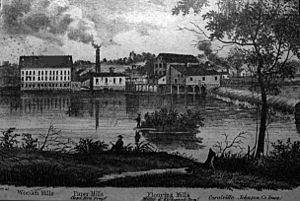
Samuel Jordan Kirkwood was born on December 20, 1813, in Harford County, Maryland. At age 17, he began teaching school and had as one of his pupils his cousin Daniel Kirkwood, who later achieved prominence as a mathematician and astronomer. Samuel spent part of his youth in Washington, D.C., then joined his father in moving to Ohio in 1835. There he became a well-known anti-slavery Republican. He was elected to several state offices and worked closely with Thomas Bartley, the future governor of Ohio, in the 1840s.
In 1855 Kirkwood moved to Iowa, living northwest of Iowa City, and became involved with the Clark family, also from Ohio, in a milling venture, and then with the Clark and Lucas families in land speculation. Kirkwood married Jane Clark, the sister of Phoebe Ann Clark, and thus became the brother-in-law of Edward Lucas, son of Iowa's first Territorial Governor Robert Lucas and his second wife Friendly Ashley (Sumner) Lucas.
Although Kirkwood intended to leave politics behind him in Iowa, he took an interest in the newly founded Republican Party. Summoned from his mill at Coralville and still coated in flour dust, Kirkwood gave a rousing speech at the founding meeting of the Iowa Republican Party in February 1856. Many people credited Kirkwood’s speech and subsequent work with the success of the Republican Party in Iowa; that year he was elected to the Iowa Senate serving from 1856 to 1859.
Governorship: Coppock incident and the Civil War
In 1859, Kirkwood was nominated for governor and defeated Augustus C. Dodge after a bitter campaign which focused on the slave issue. In 1860, Kirkwood’s first year in office, the John Brown raid on Harpers Ferry further polarized the nation over slavery, and Kirkwood was clearly on the side of the militant abolitionists. When Barclay Coppock, a youth from Springdale, who was part of Brown’s raid, fled to Iowa, Kirkwood refused to accept extradition papers for him from Virginia, and allowed Coppock to escape.
During the Civil War, Kirkwood gained national attention for his extraordinary efforts to secure soldiers and supplies from Iowa for the Union Army. A strong supporter of President Abraham Lincoln's policies during the American Civil War, he was active in raising and equipping dozens of regiments of infantry, as well as cavalry and artillery, for the Union Army.
In 1862, he attended the Loyal War Governors' Conference in Altoona, Pennsylvania, which ultimately gave Lincoln support for his Emancipation Proclamation.
Senate and Secretary of the Interior
After he left office in 1864, Kirkwood moved to a new house on Wyoming Road in Iowa City (now Kirkwood Avenue) and practiced law. About this time Kirkwood sold his share of the mill, part of it to his brother, William, and part to Valentine Miller. In 1865-1867, he served the remainder of James Harlan’s term in the U.S. Senate, and served in the Senate again from 1877 to 1881. Between his separate terms as a Senator, he was again the Governor of Iowa from 1876 to 1877. He resigned as governor in 1877 to begin his second term as U.S. Senator. In 1881, Kirkwood resigned his Senate seat to become Secretary of the Interior under President James Garfield. He served as Interior Secretary until 1882. He unsuccessfully ran for Congress in 1886.
Kirkwood died on September 1, 1894, in Iowa City, and is buried in Oakland Cemetery.
Memorials
Monuments
- Kirkwood's sculptured likeness by sculptor Vinnie Ream is maintained among the two coveted statues apportioned to each state on display under the rotunda in the National Statuary Hall Collection in the United States Capitol in Washington, D.C.
- A bust of Kirkwood is in the Vicksburg National Military Park.
- A memorial plaque is in front of Iowa City High School.
Educational institutions
- Kirkwood Community College is named for the former Iowa Governor and Senator it has several campuses in eastern Iowa.
- Kirkwood Elementary School is located in Coralville, the town where Kirkwood ran his mill.
Places
- The town of Kirkwood, Illinois.
- Kirkwood Avenue in Iowa City.
- Kirkwood Avenue in Des Moines.
- Kirkwood Boulevard in Davenport.
- The Kirkwood House in Iowa City is listed on the National Register of Historic Places.
- The Hotel Kirkwood in Des Moines, which is named in his honor, is also listed on the National Register.


